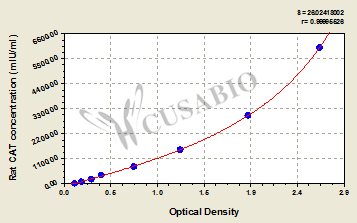The product CSB-E13439r is a ready-to-use microwell, strip plate ELISA kit for quantitatively analyzing the presence of the Catalase (CAT) in different biological samples, including serum, plasma, and tissue homogenates. This CAT ELISA kit specifically recognizes the rat CAT in the sample. It adopts the Sandwich ELISA technique in conjunction with antibody-antigen specific binding and an enzyme colorimetric reaction to indicate the presence of rat CAT and quantitatively measure the concentration of CAT in the samples.
Catalase is an antioxidant enzyme present in almost all aerobic organisms and is responsible for breaking down cellular hydrogen peroxide to generate water and oxygen thus attenuating oxidative stress. Deficiency or dysregulation of catalase is associated with the pathogenesis of various age-related degenerative disorders such as hypertension, diabetes, anemis, vitiligo, and cancer. An anomaly of catalase activity is inherited in acatalasemia, a rare genetic disease. A decrease in catalase activity in tumor patients is more likely to be due to reduced enzyme synthesis rather than to catalase mutations.






